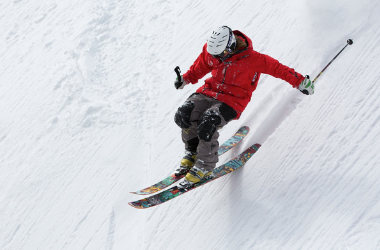Winter sports are a great way to get fresh air and exercise as a relief from being cooped up indoors. Here in the Adirondacks region, there are numerous activities available, even during the pandemic. Masking and social distancing are not hard to achieve when sledding, skating, skiing, and snowboarding.
Every sport has its risks, and winter sports are no exception. The best treatment is prevention, and there are several things you can do to minimize your risk. 
Dr. James Kelly, Saratoga Hospital Medical Group – Sports Medicine, specializes in treating injuries unique to physical exertion through sports and recreation or physically-demanding labor, as well as injuries and illness related to inactivity. Here are some of his tips to keep in mind before you hit the slopes, whether they be in the mountains or your own backyard:
- Know your limitations. Don’t try anything beyond your skill level without proper training and preparation.
- Take frequent breaks to hydrate and get warm and dry to avoid the negative effects of cold and wet on muscle and skin. This is especially important for children, even if they don’t seem tired.
- Invest in training with a subject matter expert. Formal lessons are important for safety but also to learn it correctly, ensuring a lifetime of fun.
- Pay attention to blind spots and other participants.
- Check your gear thoroughly for any signs of weakness or damage.
- Always use your protective equipment. Make sure it’s in good condition.
- Do not participate if you are overtired or under the influence of alcohol or drugs.
- Use the buddy system. Never go out alone, and bring emergency supplies.
- Pay attention to weather forecasts and changes throughout the day.
- When skating, pay attention to ice conditions from reliable sources.
This list is not all-inclusive. Layering your clothing is important, too. Include something that can break the wind, has removable sleeves, and has other various degrees of lining that can be zippered in and out or otherwise removed.
Traction cleats (spikes) are an inexpensive, easy-to-use addition to your existing footwear that can keep you from slipping, even on black ice. Keep a pair of boots or sturdy shoes handy by the front door, with the spikes already attached. This will help you keep up a nice routine of daily walks while avoiding falls.
Having your winter gear prepacked the night before will make it easier for you to be ready to go when the alarm goes off in the morning. Once you are out there, don’t be alarmed at how much harder it is to walk or play than it would be in other seasons. Extra layers, higher oxygen levels, loose snow—there are several factors that may have you out of breath sooner than you’d expect.
Be sure to research the latest information on injury prevention in your particular sport, especially knowing how to fall. If you have been injured previously, check with your healthcare provider to make sure you are ready to get back out there. Follow doctor’s orders for any additional safety equipment or restrictions.
For those who are interested in learning more about injury prevention or receiving a detailed review of their individual biomechanics and exercise physiology, Dr. Kelley is seeing patients in the Saratoga Hospital Medical Group – Sports Medicine practice in Malta. Call 518-363-8710 to make an appointment.
Monday – Thursday:
8:00 a.m. to 5:00 p.m.
Friday: 8:00 a.m. to 4:30 p.m.
Extended hours by appointment:
Friday: 7:30 a.m. to 8:00 a.m.
518-882-6955
Fax: 518-886-5880
